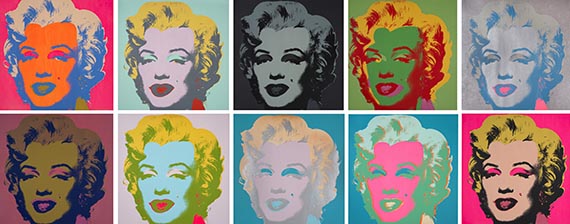Dictionary


Woodcut
The woodcut is a relief printmaking technique that was particularly widespread in the 15th and 16th centuries in the form of wood engravings. In the early 20th century the woodcut was revived with enthusiasm, especially by the Expressionists. To make the woodcut block, the part of a smoothed, longitudinally cut plank (approx 2-4 cm thick), the parts that are not to be printed are excised. For the print the artist attaches a preliminary drawing to the - usually inked - ground. Then the lines transferred to the wood surface are cut around with various woodcut tools such as gouges and knives. This is done with two cuts, oblique hatching away from the sketched line and cross-hatching. The wood in between is removed so that the lines and surfaces of the drawing remain as ridges, fillets or islands (black-line cut). The raised parts of the finished woodcut block are then inked and pressed on to lightly moistened paper (or vice versa) that soaks up the ink. The print can be made either by a flatbed printing press or by hand. The hand method entails placing a proof paper on the face-up inked block, covering it with another piece of paper and rubbing the surface with the balls of the thumbs to transfer the ink to the paper laid on the block. Another printmaking method is rubbing a baren [Japanese], a pad made of layers of cardboard, cushioned with cord and sheathed in bamboo or other materials, with a handle like a brush forcefully across the paper to achieve the necessary close contact between paper and block. The usual form of woodcut is the print made with a book printing press. It produces uniform pressure on the horizontal block so that the paper is printed uniformly. Woodcuts in large editions are printed on printing presses. Most not too resinous softwoods are suitable for making the woodcut block. For particularly detailed prints hardwoods such as pear, walnut and cherry are used. They can be cut more uniformly. However, a cheap alternative is available in the form of plywood, veneer wood and carpenter's blocks that have the additional advantage of not warping as easily as hardwood blocks. The grain or texture of the wood is used by some artists as a graphic element. The grain shows up in relief when weathered planks are used. The same effect can, however, be created by artificially "weathering" the surface of a plank with an application of dilute nitric acid.
The woodcut is a relief printmaking technique that was particularly widespread in the 15th and 16th centuries in the form of wood engravings. In the early 20th century the woodcut was revived with enthusiasm, especially by the Expressionists. To make the woodcut block, the part of a smoothed, longitudinally cut plank (approx 2-4 cm thick), the parts that are not to be printed are excised. For the print the artist attaches a preliminary drawing to the - usually inked - ground. Then the lines transferred to the wood surface are cut around with various woodcut tools such as gouges and knives. This is done with two cuts, oblique hatching away from the sketched line and cross-hatching. The wood in between is removed so that the lines and surfaces of the drawing remain as ridges, fillets or islands (black-line cut). The raised parts of the finished woodcut block are then inked and pressed on to lightly moistened paper (or vice versa) that soaks up the ink. The print can be made either by a flatbed printing press or by hand. The hand method entails placing a proof paper on the face-up inked block, covering it with another piece of paper and rubbing the surface with the balls of the thumbs to transfer the ink to the paper laid on the block. Another printmaking method is rubbing a baren [Japanese], a pad made of layers of cardboard, cushioned with cord and sheathed in bamboo or other materials, with a handle like a brush forcefully across the paper to achieve the necessary close contact between paper and block. The usual form of woodcut is the print made with a book printing press. It produces uniform pressure on the horizontal block so that the paper is printed uniformly. Woodcuts in large editions are printed on printing presses. Most not too resinous softwoods are suitable for making the woodcut block. For particularly detailed prints hardwoods such as pear, walnut and cherry are used. They can be cut more uniformly. However, a cheap alternative is available in the form of plywood, veneer wood and carpenter's blocks that have the additional advantage of not warping as easily as hardwood blocks. The grain or texture of the wood is used by some artists as a graphic element. The grain shows up in relief when weathered planks are used. The same effect can, however, be created by artificially "weathering" the surface of a plank with an application of dilute nitric acid.
Offers
Headquarters
Joseph-Wild-Str. 18
81829 Munich
Phone: +49 89 55 244-0
Fax: +49 89 55 244-177
info@kettererkunst.de
Louisa von Saucken / Undine Schleifer
Holstenwall 5
20355 Hamburg
Phone: +49 40 37 49 61-0
Fax: +49 40 37 49 61-66
infohamburg@kettererkunst.de
Dr. Simone Wiechers / Nane Schlage
Fasanenstr. 70
10719 Berlin
Phone: +49 30 88 67 53-63
Fax: +49 30 88 67 56-43
infoberlin@kettererkunst.de
Cordula Lichtenberg
Gertrudenstraße 24-28
50667 Cologne
Phone: +49 221 510 908-15
infokoeln@kettererkunst.de
Hessen
Rhineland-Palatinate
Miriam Heß
Phone: +49 62 21 58 80-038
Fax: +49 62 21 58 80-595
infoheidelberg@kettererkunst.de
We will inform you in time.




